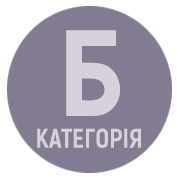THE SYSTEM OF INDICATORS OF SUSTAINABLE DEVELOPMENT AS AN INSTRUMENT OF EFFICIENT MANAGEMENT OF URBANIZED TERRITORIES
DOI:
https://doi.org/10.32851/tnv-pub.2021.1.8Keywords:
sustainable development, urbosystem, management, indicators, environment, integrated indexAbstract
While realizing the concept of sustainable development of towns and cities we face the problem of developing an effective system for evaluation of the level of their development by means of qualitative and quantitative indicators of economic, social and ecological areas. Since there is no single approach to determining sustainable development of urban territories, the formation of indication system is a topical issue nowadays. Indication system of sustainable development of Kherson is based on using the system of basic indicators combined into economic, social and ecological groups. However, it was established that the main role in the formation of territorial equilibrium is played by ecological indicators. The factors having a negative impact on the environment were determined using the model «driving force – pressure – condition – impact – reaction». It was found out that most ecological indicators are referred to negative ones, since an increase in their numerical parameters has a negative impact on the development of the urobosystem. The level of sustainable development for Kherson was determined on the basis of selection of maximal and minimal values of the indicators characteristic of typical residential territories and regions of Ukraine. Complex evaluation of ecological-economic-social condition of Kherson was performed according to the unified scale, developed by the Institute of nature management problems and ecology of the NAS of Ukraine. The results of the calculation of integrated indexes of sustainable development allow considering the ecological condition of Kherson urbosystem as satisfactory, but social and economic conditions of the town are considered as threatening. Using the integrated index of sustainable development we established that water qualitative condition by its chemical composition and soil qualitative condition by the content of heavy metals appeared to be critical indicators of the ecological group. It was determined that a high level of urbanization, intensive anthropogenic pressure on the environment, the development of depopulation processes and low investment opportunities impede the movement of Kherson to sustainable development, therefore the creation of the system of indicators of sustainable development will become a main instrument of efficient functioning of urbosystems.
References
Моисеев Н.Н. Стратегии переходного периода. Экология и жизнь. 2007. № 2 (63). С. 5–8.
Слєпишкова Л. Концепція сталого розвитку і вимоги до енергетики. Економіка України. 2002. № 9. С. 29–33.
Молдаван Л. Сталий розвиток аграрної сфери – цільовий вектор на XXI століття. Економіка України. 2009. № 11. С. 93–95.
Стольберг Ф.В. Экология города. Київ : Либра, 2000. 464 с.
Дорогунцов С., Федорищева А., Ральчук А. Устойчивое развитие в управлении эколого-економическими системами. Економика Украины. 2001. № 1. С. 75–83.
Вернадский В.И. Биосфера. Москва : Наука, 1978. 358 с.
Вернадский В.И. Несколько слов о ноосфере. Успехи биологии. 1944. № 8, Вип. 2. С. 113–120.
Руденко М. Енергія прогресу. Нариси з фізичної економії. Тернопіль : Джура, 2005. 402 с.
Ляшенко І.М. Економіко-математичні методи та моделі сталого розвитку. Київ : Вища школа, 1999. 236 с.
Криниця С.О. Формування бюджетів розвитку в регіонах України. Фінанси України. 2000. № 11. С. 9–17.
Масловська Л.Ц. Сталий розвиток продуктивних сил регіонів: теорія, методологія, практика : монографія. Київ : КНЕУ, 2003. 365 с.
Карпінський Б.А. Сталий розвиток економіки: узагальнена модель. Монографія. Львів : Логос, 2005. 256 с.
Герасимчук З.В., Галущак В.Л. Політика розвитку проблемних регіонів: методологічні засади формування та реалізації: Монографія. Луцьк : Надстир’я, 2006. 248 с.
Нестеренко О.О. Індикатори оцінки рівня сталого розвитку та їх вплив на показники інтегрованої звітності. Науковий вісник Ужгородського національного університету. Випуск 15. Частина 2. 2017. С. 44–50.
Публічне управління в забезпеченні сталого (збалансованого) розвитку : [навч. посіб.]. Т.К. Гречко, С.А. Лісовський, С.А. Романюк, Л.Г. Руденко. Херсон : Грінь Д.С., 2015. 264 с.
Регіональна доповідь про стан навколишнього природного середовища в Херсонської області у 2018 році. Херсон : Херсонська ОДА, 2019. 238 с.
Статистичний щорічник Херсонської області за 2017 рік / За ред. В.А. Вознюка. Херсон : Головне управління статистики у Херсонській області. 2018. 452 с.
Статистичний щорічник України за 2019 рік / за ред. І.Є Вернер. Київ, 2020. 464 с.
Згуровский, М.З. Сталий розвиток у глобальному і регіональному вимірах: аналіз за даними 2005р. Київ : НТУУ «КПІ», ВПІ ВПК «Політехніка», 2006. 84 с.
Cкок С.В. Стратічук Н.В. Науково-методичні аспекти оцінки сталого розвитку міських екосистем. Екологічні науки. Випуск 1 (28). 2020. С. 367–372.






